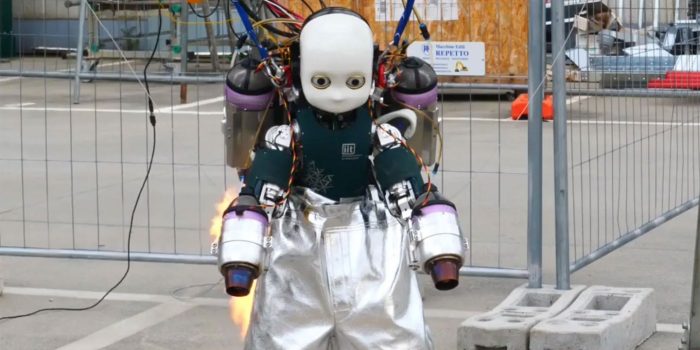The Italian Institute of Technology (IIT) has developed a jetpack-wearing humanoid robot with a disturbing, doll-like face.
The scary jetpack doll may appear terrifying, but the researchers believe it could one day be used to navigate otherwise impassable terrain and aid in disaster relief. A lovely video render shows the robot doing just that, gliding over some wreckage with ease.
The researchers put some slick protective leggings on the jetpack doll and let the four jet engines rip in a real-world test — which, it must be acknowledged, is virtually a scenario straight out of a horror sci-fi movie. While the robot couldn’t hover, the researchers were able to track changes in the robot’s weight thanks to two scales it stood on during the test.
According to a paper recently accepted for publishing in the journal IEEE Robotics and Automation Letters, the terrifying beast known as iRonCub (iCub Equipped with Jet Engines) has two jet engines mounted to the ends of each of its arms and another two attached to its backpack.
The iRonCub isn’t the only humanoid robot that has recently been created for flight. Caltech researchers unveiled footage of their bipedal robot flying, balancing on a tightrope, and skateboarding with the help of two drone rotors in October.
Robotics is a scientific area that has always been driven by creative engineering applications, frequently spurred on by the human desire to have greater movement and interaction capabilities.
Manipulation and locomotion on robotic platforms, on the other hand, remain a major issue for the robotics field.
Researchers noted in the paper that Humanoid Robotics and Aerial Manipulation are combined in Aerial Humanoid Robotics. Aerial humanoid robots can thus overcome the limitations of terrestrial mobility of aerial manipulators and expand humanoid robot locomotion skills to the flying situation. Aerial humanoid robots can therefore walk, fly, operate, and transport objects, providing more energy-efficient payload transportation and object manipulation options.


